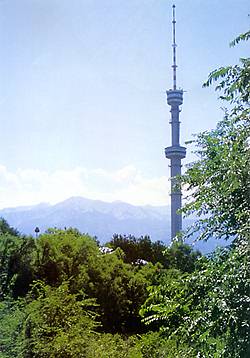 Almaty
means 'apple place'
Almaty
means 'apple place'
(article from TRANSAERO in-flight
magazine by Irina Zhirnova, pictures by Vladimir Averyanov)
Every city has a symbol of its own,
some sort of a visiting card. For example, Moscow has the
Kremlin and Paris has the Eiffel Tower. The Almaty silhouette
is unthinkable without the mountains that surround the city's
residential areas. These are part of the Trans-Ili Alatau
Range (alatau means 'speckled mountains'). Any air traveler
wishing to test the accuracy of this name must be watchful
during the last few minutes prior to landing when the plane
swoops over the great bowl of the city. It is the early hours
of the morning. The rays of the rising sun impart a pale
orange hue on the snow-capped mountain peaks. The next minute
the blazing disc of the sun will emerge from behind the
clouds. Now an occasional air traveler can see the wild rocky
slopes furrowed by mountain streams that look like thin
threads, the prim Tien Shan pines and huge boulders - the
material evidence of past mudflows. It is the mountains that
shape the Almaty climate. As few as 50 kilometers away lie
the shifting sandhills of the Balkhash desert. In summer, the
soil here is scorched by the sun and in winter fierce winds
sweep over the area and the temperature drops below minus 30
degrees Centigrade. The weather conditions in the city of
Almaty are much milder: the average temperatures are +8°C in
winter and +22°C in summer. The coldest month is January
when it can be extremely cold, while in July and August the
thermometer may read well above +30°C. On the whole, the
mountains give the local climate a milder note, which has
historically made it possible for apple orchards to grow
along the banks of the Bolshaya (Greater) Almaatinka and
Malaya (Lesser) Almaatinka rivers. That was how the city
received its name: Almaty means literally "apple
place."
On the Silk Road of History
 Central
Asia, of which Kazakhstan is a part, is considered to be the
birthplace of an ancient culture closely associated with the
nomadic peoples of the Great Steppe. Kazakhstan lies at the
crossroads of ancient civilizations, the intersection of
major transportation routes, cultural, economic, social and
ideological links between Europe and Asia, between the East
and the West. Already during the early centuries of the 1st
millennium B.C. the steppe region of Central Asia was
dominated by the prosperous Scythian civilization. Even today
the archaeologists who dig the kurgans (ancient burial
mounds) find bronze and golden artifacts that can be dated
back to those times. During the subsequent centuries, the
Kazakhstan steppes became home to the powerful realm of the
Huns. Their leader, Attila, helped cause the downfall of the
Great Roman Empire and introduced the prototype of men's
trousers to Europeans. The Huns were forced out by Turkic
tribes whose khanates extended from the Yellow to the Black
Sea. At that time cities and caravansaries began to emerge
within the oases of Central Asia, forming the Silk Road that
linked Byzantium and China; another link - the "sable
route" - was established via the Central Kazakhstan and
Altai into the southwestern regions of Siberia for the
purpose of transporting expensive furs to markets in Europe
and in the Middle East. From the 8th century A.D. onwards,
sedentary settlements began to emerge in the area now
occupied by the city of Almaty. By the start of the 13th
century they had developed into urban communities with high
level of social organization by contemporary standards. Some
of them had public baths, sanitation and water supply
systems; goods would be traded for gold and copper dug from
the Alatau Mountains. The armies of Genghis Khan and later of
Tamerlane rolled over Almaty but each time the city was able
to recover because of its unique geographic location: the
Silk Road made it an indispensable stopover place for traders
and travelers. Times changed, however, and great geographical
discoveries prompted the emergence of marine trade routes.
Many a city began to decline. It seemed that the last page
was being turned over in the history of Almaty.
Central
Asia, of which Kazakhstan is a part, is considered to be the
birthplace of an ancient culture closely associated with the
nomadic peoples of the Great Steppe. Kazakhstan lies at the
crossroads of ancient civilizations, the intersection of
major transportation routes, cultural, economic, social and
ideological links between Europe and Asia, between the East
and the West. Already during the early centuries of the 1st
millennium B.C. the steppe region of Central Asia was
dominated by the prosperous Scythian civilization. Even today
the archaeologists who dig the kurgans (ancient burial
mounds) find bronze and golden artifacts that can be dated
back to those times. During the subsequent centuries, the
Kazakhstan steppes became home to the powerful realm of the
Huns. Their leader, Attila, helped cause the downfall of the
Great Roman Empire and introduced the prototype of men's
trousers to Europeans. The Huns were forced out by Turkic
tribes whose khanates extended from the Yellow to the Black
Sea. At that time cities and caravansaries began to emerge
within the oases of Central Asia, forming the Silk Road that
linked Byzantium and China; another link - the "sable
route" - was established via the Central Kazakhstan and
Altai into the southwestern regions of Siberia for the
purpose of transporting expensive furs to markets in Europe
and in the Middle East. From the 8th century A.D. onwards,
sedentary settlements began to emerge in the area now
occupied by the city of Almaty. By the start of the 13th
century they had developed into urban communities with high
level of social organization by contemporary standards. Some
of them had public baths, sanitation and water supply
systems; goods would be traded for gold and copper dug from
the Alatau Mountains. The armies of Genghis Khan and later of
Tamerlane rolled over Almaty but each time the city was able
to recover because of its unique geographic location: the
Silk Road made it an indispensable stopover place for traders
and travelers. Times changed, however, and great geographical
discoveries prompted the emergence of marine trade routes.
Many a city began to decline. It seemed that the last page
was being turned over in the history of Almaty.
 The
Kazakhs Are a Freedom-Loving People
The
Kazakhs Are a Freedom-Loving People
In 1245, the word Kazakh (translated
from the ancient Turkic as "freedom-loving,
independent") emerged in the TurkicArabic dictionary
which had presumably been compiled in Egypt. The word would
be used to describe individuals who deserted their people or
nomadic tribe and fought on the side of the enemy. The
formation of the Kazakh nationality, which began long before
the Mongol invasion, took up several centuries and reached
completion in the early decades of the 16th century. All the
ancient tribes that formed the ethnic backbone of the Kazakh
nationality belonged to the so-called South Siberian
Mongoloid type, spoke mutually understandable Turkic dialects
and were pastoral nomads. The immense territory of today's
Kazakhstan was divided into separate khanates that were in a
continuing state of feud till the early decades of the 17th
century. In 1740 the Dzungars, a Western Mongol tribe,
invaded Kazakhstan. The people of Kazakhstan began a
century-long war against the invaders who had been able to
quickly seize vast territories, impose heavy taxes and slay a
substantial proportion of the indigenous population. Because
their independence and security had been put at risk, the
Kazakh khans turned for help to their powerful neighbor -
Russia. On February 19, 1731, the Little Horde (the
federation of tribes in the western part of Kazakhstan) was
formally incorporated into Russia, followed by the Middle
Horde in 1740 and four clans of the Great Horde (the tribes
in the southern and southeastern parts of Kazakhstan) in
1742. At last the long-sought protection was secured. It was,
however, no charitable deal. Russia began to encroach on
Kazakh territory by building fortresses and initiating
mass-scale migration of Russian population to Kazakhstan from
Russia's inner areas. Pastures would be parceled out to
Russian farmers and territorial division would be adapted to
Russian patterns. Modern-day Almaty stands where in 1854 the  Russians
established the military fortification of Verny. The ruins of
the fortress can still be seen on the left bank of the Malaya
(Lesser) Almaatinka river. The Russian military officers
chose a perfect location for the strongpoint: the naturally
protected river valley provided a rich supply of construction
stone, the hills around it abounded in timber and lying
nearby were fertile lands and hayfields generously watered by
mountain streams. Cossacks and Siberian settlers soon
established themselves in the vicinity giving root to the
Bolshaya and Malaya stanitsas (Cossack villages), while
Western Siberian settlers and migrants from Semipalatinsk
created the Tatar slobodka (suburb). The Dunganskaya slobodka
became the settlement place for Dungans and Uighurs who
migrated to the area from China. In 1867 the fortification
became the town of Verny and the administrative center of
newly created Semirechye province. The new town with its
well-planned wide streets lined with water ditches and
numerous trees emerged in the southwestern part of the area
directly adjoining the Bolshaya stanitsa. The great mountains
encircled the town on its periphery, creating an atmosphere
of peace and security. The first disaster struck in May 1887.
An earthquake of magnitude 10.0 destroyed virtually every
stone building in the town of Verny. Only the wooden
structures survived the shock. For many years thereafter the
town would be mainly built with onestoried timber houses
richly decorated with carved woodwork, which gave the place a
unique charm. The next major earthquake occurred in January
1911. It brought a new wave of devastation; surprisingly, the
town's cathedral church (54 meters high) was left intact
except for a slightly bent cross on one of its domes. There
were contradictory explanations of that, ranging from Divine
Providence to the high quality of architectural design and
masonry.
Russians
established the military fortification of Verny. The ruins of
the fortress can still be seen on the left bank of the Malaya
(Lesser) Almaatinka river. The Russian military officers
chose a perfect location for the strongpoint: the naturally
protected river valley provided a rich supply of construction
stone, the hills around it abounded in timber and lying
nearby were fertile lands and hayfields generously watered by
mountain streams. Cossacks and Siberian settlers soon
established themselves in the vicinity giving root to the
Bolshaya and Malaya stanitsas (Cossack villages), while
Western Siberian settlers and migrants from Semipalatinsk
created the Tatar slobodka (suburb). The Dunganskaya slobodka
became the settlement place for Dungans and Uighurs who
migrated to the area from China. In 1867 the fortification
became the town of Verny and the administrative center of
newly created Semirechye province. The new town with its
well-planned wide streets lined with water ditches and
numerous trees emerged in the southwestern part of the area
directly adjoining the Bolshaya stanitsa. The great mountains
encircled the town on its periphery, creating an atmosphere
of peace and security. The first disaster struck in May 1887.
An earthquake of magnitude 10.0 destroyed virtually every
stone building in the town of Verny. Only the wooden
structures survived the shock. For many years thereafter the
town would be mainly built with onestoried timber houses
richly decorated with carved woodwork, which gave the place a
unique charm. The next major earthquake occurred in January
1911. It brought a new wave of devastation; surprisingly, the
town's cathedral church (54 meters high) was left intact
except for a slightly bent cross on one of its domes. There
were contradictory explanations of that, ranging from Divine
Providence to the high quality of architectural design and
masonry.
 Andrei
Zenkov—the Russian Architect of the Kazakh Land
Andrei
Zenkov—the Russian Architect of the Kazakh Land
A well-known author, Yuri Dombrovsky,
wrote some 35 years ago that Alma-Ata was unthinkable without
the architectural creations of Zenkov. "Although he was
fond of architectural adornments, carved woodwork and
corrugated iron, he also possessed some honest and clear
vision of detail, something that prompts to compare his
buildings with a Christmas tree decorated from top to bottom.
Here is a star and here are some cockerels along with some
baubles and scrolls that make no sense at all, and lots of
other hodgepodge stuff. On the other hand, his buildings
possess a festive look, striking a jubilant and triumphant
key. He wanted people to feel happy and look at his creations
with surprisea Just throw Zenkov's funny towers and
gingerbread palaces out of Verny and the modem-day Alma-Ata
will never be the same. More than that - it will become
different, for it will become devoid of its chief decoration
and natural hub: the amazing cathedral as created by Zenkova"
The cathedral was built in 3 years and was consecrated in
1907. The building was designed to accommodate 1,500
worshipers and its interior walls were decorated with 83
icons. Nearly all of the icons were lost during the long
decades when during Soviet times the cathedral building
housed the Central Republican Museum. At one time the
authorities contemplated its demolition but God stood over
it, preventing every intrusion and calamity. When in 1991
Kazakhstan became an independent state, a decision was taken
to put the cathedral in the custody of the Church.
Restoration work began, which included the removal of the
museum-related appendages. As of today, numerous partitions,
topside coverings and the inner peripheral gallery have been
removed. Column capitals and bases and ornamental belts were
built anew. Lying ahead is the job of revamping the facades
and restoring the iconostasis to its erstwhile beauty. On
April 24, 1995, the first modern-day service was held at the
Almaty Cathedral. It seemed that the heavenly forces rejoiced
in unison with the worshipers on that day: a rainbow appeared
in the clear skies above the cathedral, witnessed by every
city inhabitant.
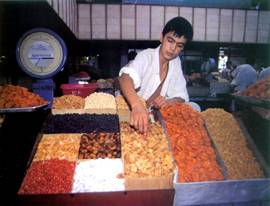 The
Eleventh Republic Within the Union
The
Eleventh Republic Within the Union
In 1920 Kazakhstan became an
autonomous republic within the USSR and in 1936 it received
the status of the eleventh Union Republic. Aware of the
economic backwardness of Kazakhstan, the Communist party
leadership directed considerable resources to accelerate
economic growth in the region. Already in the 1930s the
semi-wild nomadic land was transformed into a prosperous
industrialized area with well-developed land cultivation and
livestock breeding sectors. There emerged railways and
automobile roads and mining industries began to find their
feet. As of 1991, Kazakhstan was producing 70% of the entire
Soviet Union's output of lead, zinc, titanium, magnesium and
tin; 90% of phosphorus and chromium; over 60% of silver and
molybdenum. The ethnic makeup of Kazakhstan's population
changed under the Soviet rule. Kazakhstan was the only Soviet
republic where the indigenous population constituted a
minority. The underlying reasons included enormous human
losses during the two World Wars, famine and purges,
mass-scale deportation to Kazakhstan of Russians regarded
undesirable by the Soviet regime. One can hardly expect to
hear Kazakh speech in the streets of Almaty these days.
Bilingual signs can be seen in every store and government
office and Russian-language editions dominate the newsstands
and bookshops. It is only at the Republican Museum of
Traditional Musical Instruments that a native bard, akyn,
welcomes visitors with a ballad sung in Kazakh.
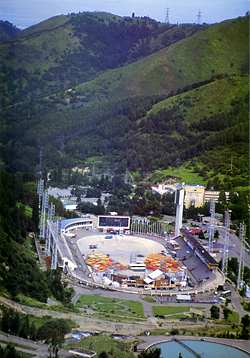 What
Can Be Better Than Mountains? Just Other Mountains
What
Can Be Better Than Mountains? Just Other Mountains
To visit Almaty and to see nothing of
its mountains would be a waste of time and money. For a
start, one may take a ride on the cableway that goes above
the old part of the city. It will take you several minutes to
complete the overhead ride across Almaty during which you
will get a breathtaking panorama of the city. The cableway
goes as far as the Kok-Tyube peak (1,130 meters), below which
stands the city's 350-meter television tower. The Medeo gorge
is probably the most visited and attractive site within the
Almaty area. It derives its name from that of an
ancient-times nomad, Medeo, who founded a village in that
fabulous place. The road to Medeo snakes along the Maloye
Almatinskoye Ushchelye (canyon). This is where mountain
resorts, sanatoriums and private estates are located, hence
the continuous fence that obstmcts intrusion. The two
pleasant exceptions are a diner and a grillroom built in a
hunting-lodge style, where travelers can enjoy the famous
taste of the Kazakh shashlyk. Running parallel to the road is
a turbulent mountain stream, favored by the followers of
Porfiry Ivanov, the notorious ice bath gum. Anyone entering
the Medeo site is supposed to pass through an environmental
checkpoint and pay the entrance fee. The funds thus collected
are diverted to anti-mudflow reinforcement. The city still
keeps the memory of the dreadful mudslide disaster of 1921
when a stream of mud, sand and stones (weighing 20 to 25 tons
each) came crashing on Almaty, destroying almost the whole of
the city's eastern part. The Medeo ice-skating stadium looks
magnificent in any weather. It can be viewed from an
observation platform above it, which can be accessed by
climbing 800 steps of a dedicated staircase or by taking a
diversion route around Mt. Mokhnatka. The mountain once
accommodated a cave church and a secluded monastery. Pilgrims
still visit this holy place and hold improvised worship
ceremonies. Once a year the Medeo stadium would be de-iced
and transformed into a huge concert stage. It becomes the
venue of the much-acclaimed "Voice of Asia" (Azia
Dauysy) popular song festival that draws together not only
young Kazakh singers but also world-famous pop-stars. This
year the top event at the festival was the honoring of the
internationally recognized opera singer, a legendary figure
in Kazakh artistic community, People's Artist of the USSR
Yermek Serkebayev. For more than 50 years he had been the
leading singer at the Abai Opera and Ballet Theater; he
founded a musical dynasty and created his own school in vocal
art.
 Those
who seek stomach-turning sensations may try the skiing resort
of Chimbulak located beyond Medeo at the altitude of 2,230
meters. The 1.5-kilometer cableway will get you near the
Great Talgar Pass at an altitude of about 3,000 meters to the
uppermost point of a high-speed downhill track. The most
daring skiers may go past Chimbulak to the hikers' camp
Edelweiss, or still higher (3,400 meters) to the Mynzhiiki
gorge beyond which lie the Tuyuksu and Igly Tuyuksu glaciers.
Those
who seek stomach-turning sensations may try the skiing resort
of Chimbulak located beyond Medeo at the altitude of 2,230
meters. The 1.5-kilometer cableway will get you near the
Great Talgar Pass at an altitude of about 3,000 meters to the
uppermost point of a high-speed downhill track. The most
daring skiers may go past Chimbulak to the hikers' camp
Edelweiss, or still higher (3,400 meters) to the Mynzhiiki
gorge beyond which lie the Tuyuksu and Igly Tuyuksu glaciers.
Kazakhstan is an ideal place for offbeat outdoor
recreation activities, such as hunting. Wolf-hunting is the
most exciting and spectacular form of hunting. At present,
the population of wolves in Kazakhstan has reached 125,000
animals and continues to grow. Wolves have been inflicting
serious damage both on the economy of the region and on its
fauna. Apart from being an exciting sport, wolf-hunting is
therefore a compelling necessity as it helps to keep the
number of wolves to a tolerable level. During the hunting
season which lasts from November 15 to March 15, the daily
take by hunters, out on a shooting raid in the area 230 km to
the southwest of Almaty, may go up to 10 slain animals. Other
traditionally hunted animals in Kazakhstan include the saiga,
the maral, the Asiatic ibex, the dzheiran gazelle and the
Siberian roe deer. The Bukhara deer is exotic as there are
only about 300 animals of this species left on the Earth;
this being so, only one hunting permit is issued annually for
the Bukhara deer. Kazakhstan is a paradise for lovers of
sport fishing: Lake Balkhash situated 350 km away from Almaty
is famous for its perches. The Balkhash perch is a huge fish:
a 100-kilo specimen would be regarded as a routine catch,
although fishes weighing up to 200 kilos are not rare. One
ofAlmaty's best-known health resorts—theAlatau sanatorium—is
situated in a picturesque suburb at the foot of the mountains
that encircle the city. It was built during 1982-1986 near a
mineral spring. The place is an eclectic combination of
traditional Kazakh architectural adornments and leading-edge
medical equipment for the treatment of gastrointestinal
diseases, spine and bone joint ailments, cardiovascular,
urological, gynecological and nervous disorders. Alongside
traditional treatment, the facility offers the services of a
mudbath, a sauna bath, douches and bathrooms, as well as
massage parlors. There are also exercise rooms, a gymnasium
and rooms for therapeutic physical training. Outdoor
facilities include golf links and tennis courts; the aquatic
sport lovers may enjoy a ride in a rowing boat or a catamaran
at the nearby man-made lake. Apart from that, taking a
leisurely stroll across the vast and woody grounds of the
sanatorium can give one real pleasure. That is, anyone who
has visited the place will hardly ever want to spend a
vacation at a European resort.
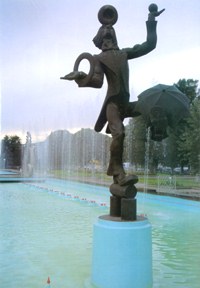 Almaty,
the "Apple Place"
Almaty,
the "Apple Place"
Anyone who walks down the Almaty
streets for the first time would be amazed by the close
coexistence of its old and new buildings. The magnificent
cathedral overlooks the Panfilov Heroes Memorial; the huge
concrete edifice of the Military Officers House towers above
the ancient building of the Museum of Traditional Musical
Instmments. The era of small wooden cottages is passing away.
Modem technology makes it possible to construct high-rise
comfortable buildings even in this zone of considerable
seismic risk. A good example is provided by the five-star
"Hayatt Regency Almaty" Hotel, a conglomerate of
all thinkable amenities and services: satellite TV and
satellite phones, non-smoking areas, sky-lobby elevators, the
Yurta Bar with its traditional Kazakh atmosphere and the
European-style Vienna cafe. The local restaurant "Zhambyl"
offers a rich gastronomic choice from international and
traditional cuisines. Visiting business people will look
forward to using the services of the hotel's Business Center
equipped with up-to-date office machinery.
 The
city has good facilities for children's recreation. President
Nursultan Nazarbayev made his New Year gift to the city
children by inaugurating a Disneyland-type amusement park.
When the daytime heat subsides, citizens would take their
offsprings to the park's water rides, the horror labyrinth,
the countless carousels and merry-go-rounds the sheer sight
of which gives a week-knee feeling to many an adult. The
adult citizens would frequently spend their evenings at
numerous cafes and restaurants. The best-known and the most
visited place is the Silk Road Restaurant offering Chinese
and Korean cuisines - a Beijing roasted duck may go well with
French wines and ice-cream made from a bisected pineapple. I
strongly suggest, however, that you try some traditional
dishes of horseflesh and mutton with hot sauce, as well as
manty, chebureks and belyashi. The gourmets would appreciate
beshbarmak - a mutton dish with lots of onion, which
according to the local custom must be picked by hand. A truly
fine custom!
The
city has good facilities for children's recreation. President
Nursultan Nazarbayev made his New Year gift to the city
children by inaugurating a Disneyland-type amusement park.
When the daytime heat subsides, citizens would take their
offsprings to the park's water rides, the horror labyrinth,
the countless carousels and merry-go-rounds the sheer sight
of which gives a week-knee feeling to many an adult. The
adult citizens would frequently spend their evenings at
numerous cafes and restaurants. The best-known and the most
visited place is the Silk Road Restaurant offering Chinese
and Korean cuisines - a Beijing roasted duck may go well with
French wines and ice-cream made from a bisected pineapple. I
strongly suggest, however, that you try some traditional
dishes of horseflesh and mutton with hot sauce, as well as
manty, chebureks and belyashi. The gourmets would appreciate
beshbarmak - a mutton dish with lots of onion, which
according to the local custom must be picked by hand. A truly
fine custom!
Although on December 10, 1997, Almaty
ceased to be the nation's capital, it has remained a major
industrial and cultural center, the site of important
educational establishments, theaters (such as the Abai
National Opera and Ballet Theater, the Auezov Kazakh Drama
Theater, the Lermontov Russian Drama Theater), a circus and
numerous concert halls that host performances by
world-renowned artists.
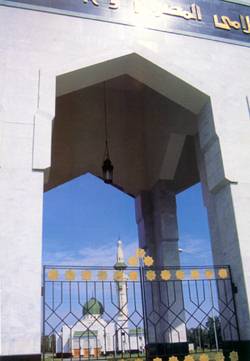 The
Central National Museum has on its display over 200,000
exhibits presenting the historical and cultural legacy of the
Kazakh people. The collection of the Kasteyev National Museum
of Fine Arts includes more than 20,000 original works by
contemporary and old Kazakh, Russian, European and Oriental
artists. Places of religious worship are also being built in
Almaty. Alongside a number of newly erected mosques and
Orthodox churches, special mention should be made of the
Egyptian Islamic Center and the Mubarak Islamic University -
the Egyptian Government's gift to Almaty.
The
Central National Museum has on its display over 200,000
exhibits presenting the historical and cultural legacy of the
Kazakh people. The collection of the Kasteyev National Museum
of Fine Arts includes more than 20,000 original works by
contemporary and old Kazakh, Russian, European and Oriental
artists. Places of religious worship are also being built in
Almaty. Alongside a number of newly erected mosques and
Orthodox churches, special mention should be made of the
Egyptian Islamic Center and the Mubarak Islamic University -
the Egyptian Government's gift to Almaty.
Meanwhile, Russia remains a major partner of
Kazakhstan in every sphere of activity. It was no coincidence
that on July 6, 1998, his birthday, which he spent in Moscow,
Nursultan Nazarbayev joined Boris Yeltsin in signing the
"Declaration of Eternal Friendship and Cooperation into
the 21st Century." The two presidents also signed a
number of other documents that bore less poetic titles, such
as the accord on the demarcation of the Caspian Sea and the
financial settlement agreement. Apparently, the signing of
these documents will further enhance the cooperation between
the two powers, although the strong interaction between them
is already evidenced by the fact that tickets for the
Transaero's Moscow-Almaty flight are sold out long in
advance.
 Regrettably,
the introduction of additional flights along that route is
being delayed by the sluggish repairs of airport facilities.
Having lived through euphoria brought about by the newly
gained independence and through a period of alienation, the
former Soviet republics, like other countries of the world,
are now seeking common ground. Standing close to Russia
alongside the Slavic countries of the former Soviet Union is
Kazakhstan, linked to it by a century-long relationship, and
its capital city Almaty, smelling of apples and encircled by
snow-capped mountains. The sight of those mountain peaks
causes one to reflect upon eternal values, including the
loftiest purpose of the human life—to do good to other
people.
Regrettably,
the introduction of additional flights along that route is
being delayed by the sluggish repairs of airport facilities.
Having lived through euphoria brought about by the newly
gained independence and through a period of alienation, the
former Soviet republics, like other countries of the world,
are now seeking common ground. Standing close to Russia
alongside the Slavic countries of the former Soviet Union is
Kazakhstan, linked to it by a century-long relationship, and
its capital city Almaty, smelling of apples and encircled by
snow-capped mountains. The sight of those mountain peaks
causes one to reflect upon eternal values, including the
loftiest purpose of the human life—to do good to other
people.
 When
you go high into those mountains and reach a mountain pass,
you will be compelled to follow a Buddhist custom and tie a
ribbon round a tree—so that some day you could come back
and experience the simple but important truths that reveal
themselves to a person who dares to explore this challenging
and stunningly beautiful land.
When
you go high into those mountains and reach a mountain pass,
you will be compelled to follow a Buddhist custom and tie a
ribbon round a tree—so that some day you could come back
and experience the simple but important truths that reveal
themselves to a person who dares to explore this challenging
and stunningly beautiful land.
Transaero offers regular flights
from Moscow to Almaty daily at 22.45
![]()